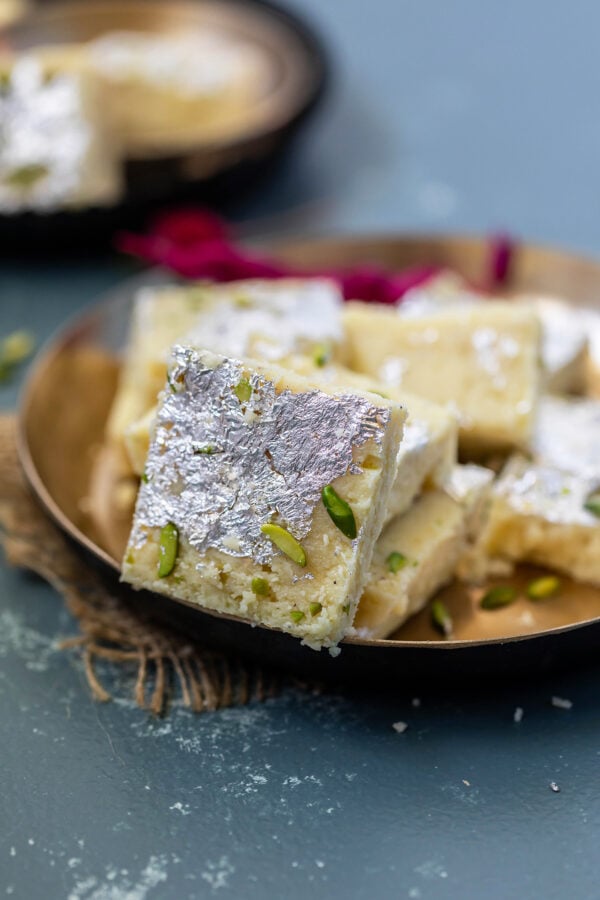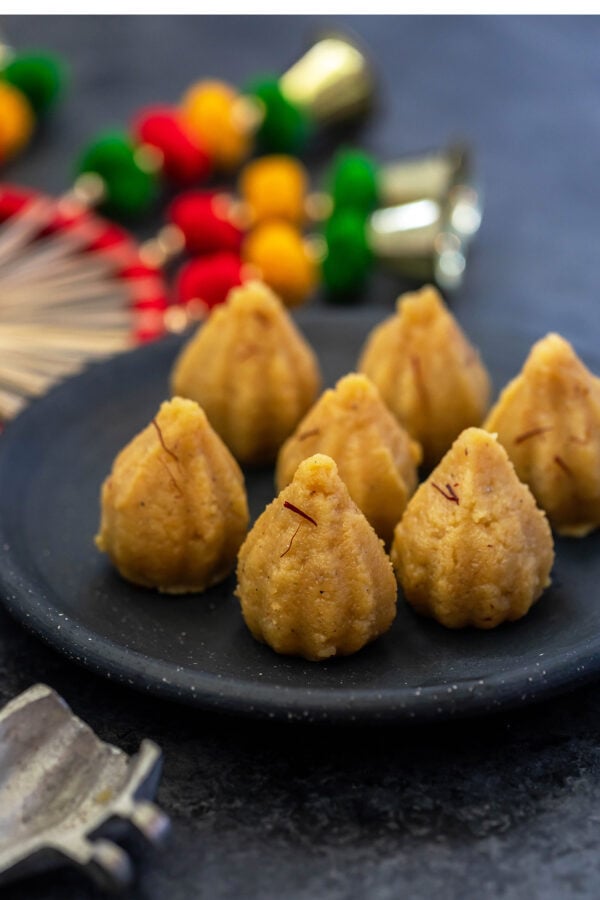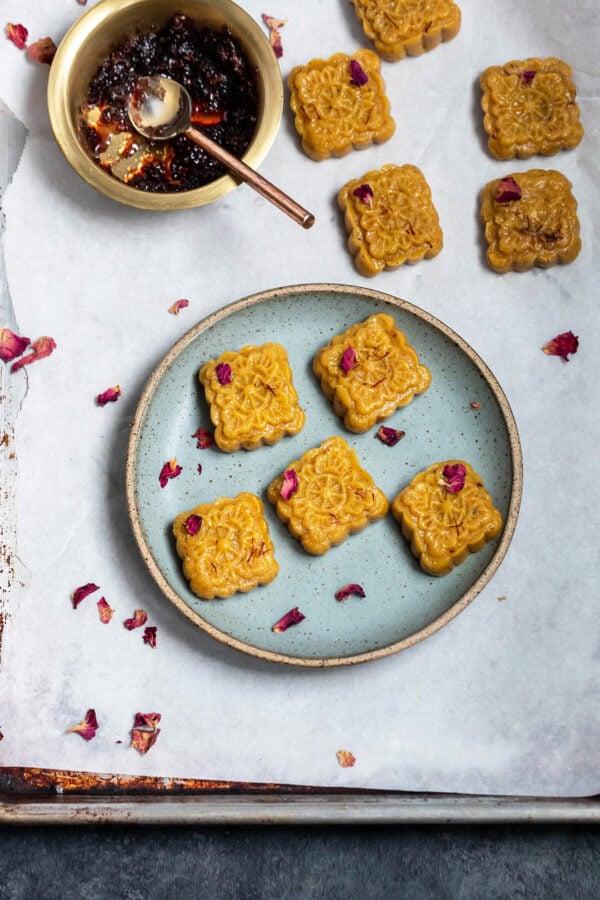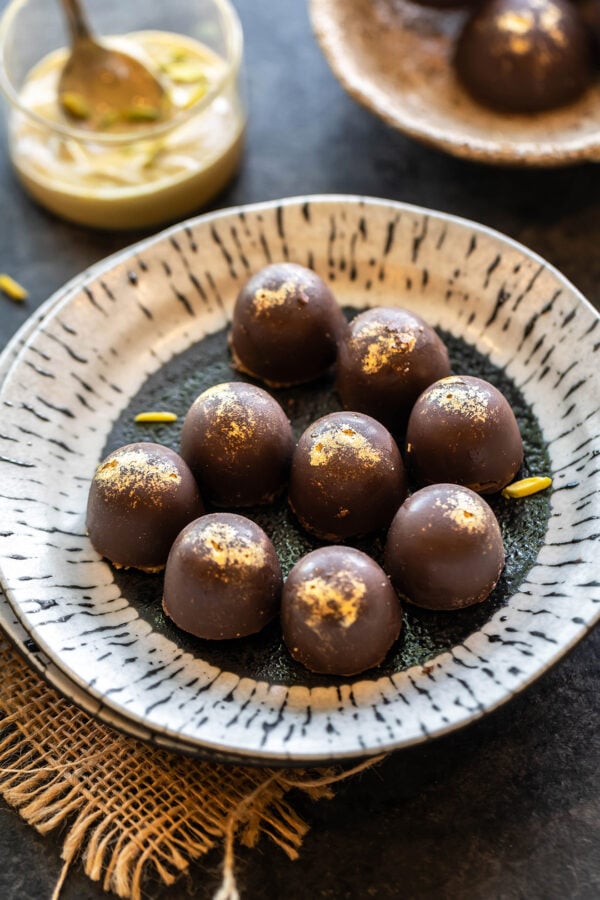This post may contain affiliate links. Please read our disclosure policy.
Whole wheat flour (atta) is slow roasted in ghee and then mixed with nuts, sugar and raisins to make a hearty dish called Panjiri which is popular in northern parts of India especially during winter months as it’s supposed to keep you warm. This is a dish that I grew up eating as my nani (maternal grandmother) used to make this a lot for us when we were kids. Many Panjiri recipes online call for using different flours like besan or using lots of seeds like melon seeds, pumpkin seeds etc. but my nani kept it very simple. She used just atta, ghee and nuts in her panjiri and that’s exactly how I make mine.
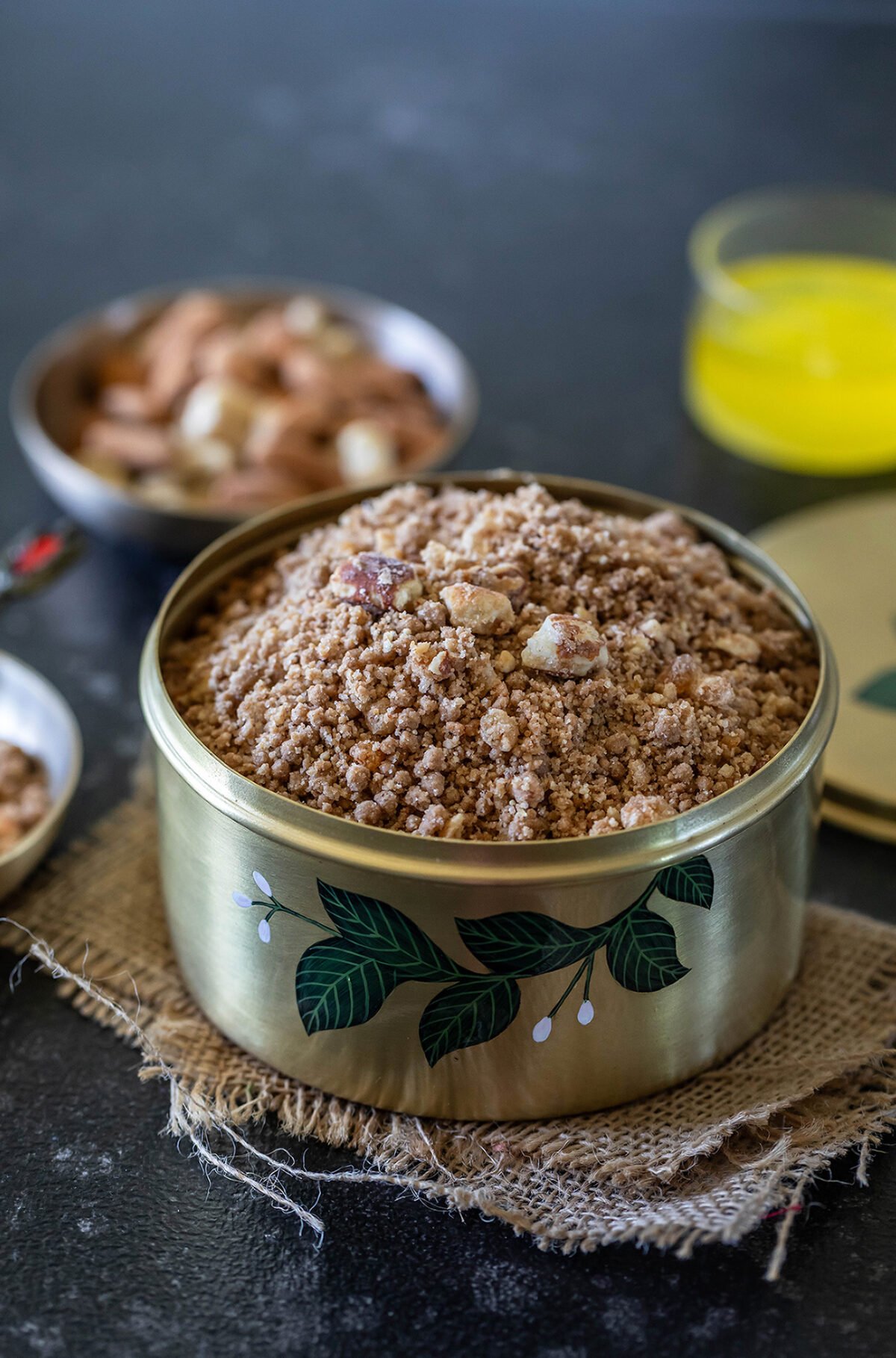
At my home in India, winters were really special, evenings were filled with copious amounts of chai and bowls of gajar halwa. Mornings were all about gorging on fresh methi parathas, and for dinner, there was always Nimona! I have so many memories etched in my heart of these wonderful winter dishes that I grew up eating.
Another favorite winter staple was Panjiri, which my nani used to make. I was always a big fan of atta halwa, so it wasn’t surprising that I loved panjiri too. Both are essentially made with the same ingredients except they differ completely in texture. I would wander around the kitchen while panjiri was being made because the aroma of atta being roasted in ghee was hard to ignore!
The best part about panjeeri is that it lasts long at room temperature. And here in Seattle, I actually don’t wait for winters to make Panjiri, because it’s cold and grey 9 months out of 12 so I can have it whenever I want!
Let’s Make Panjiri
- Fry the nuts, raisins and edible gum in ghee
Start by frying the nuts first in ghee until they are lightly browned and then remove from the kadai. I used cashews and almonds here but you can also use pistachios, walnuts etc. Then fry gond (edible gum). One thing to remember with gond is that the ghee needs to be hot when you add the gum to it and it will swell up nicely and will then be easier to crush. Also fry the raisins until they plump up. Remove everything on a plate before proceeding to the next step of roasting the atta.
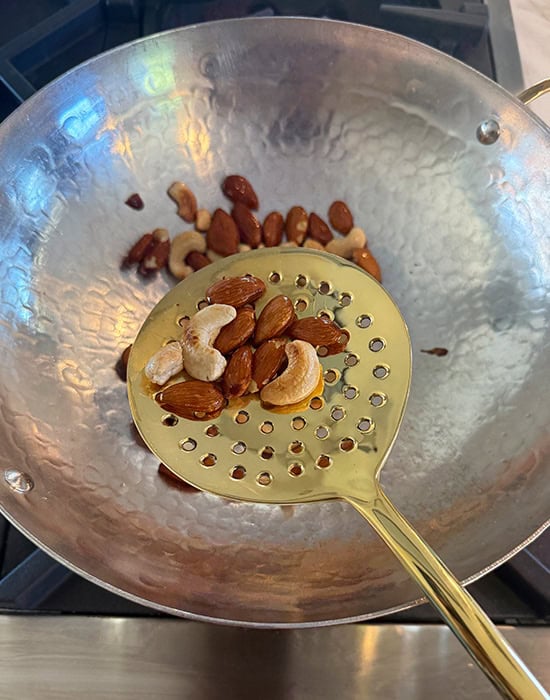

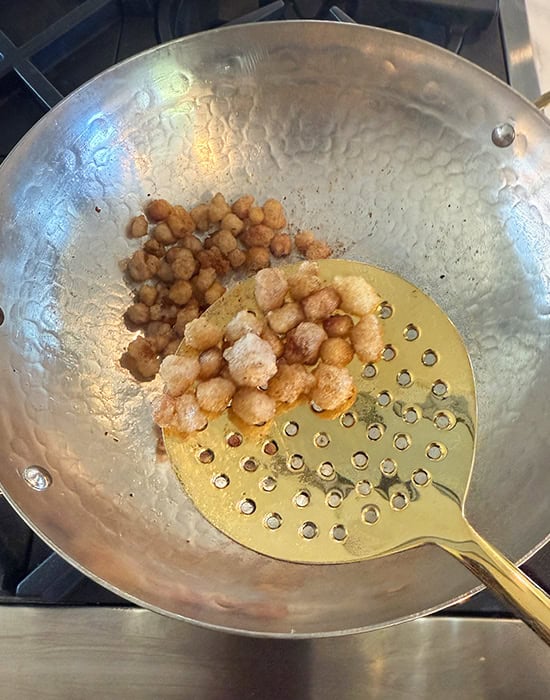

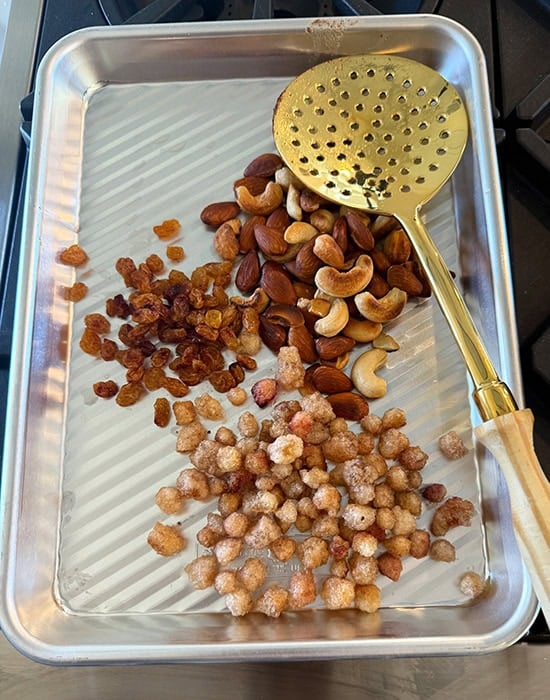
- Roast atta with ghee on low heat
This step takes the most amount of time but is also the most important. You need to roast the atta in ghee while stirring continuously on low heat until it’s fragrant and golden brown in color. If your atta isn’t roasted properly, your panjiri will have that kachha (raw) taste and honestly that will spoil the whole panjiri. If you roast on high heat, then the atta will become brown quickly but will still be raw. So, the only way to go is low and slow. Once roasted, take out the atta on a large paraat (plate) and continue to stir it for 2 more minutes so that it doesn’t burn since it has a lot of heat retained inside it. And then let it come down to room temperature.
This takes around 15 to 20 minutes of constant stirring on low heat. Do not leave it unattended else atta will burn. It’s also important to use a heavy bottom pan or kadai for this to minimize rhe risk of atta getting burnt. An iron kadai or a brass kadai works great.
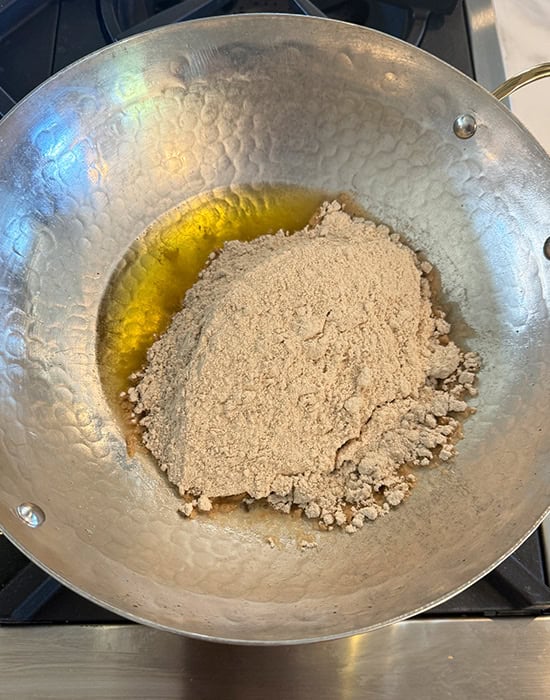
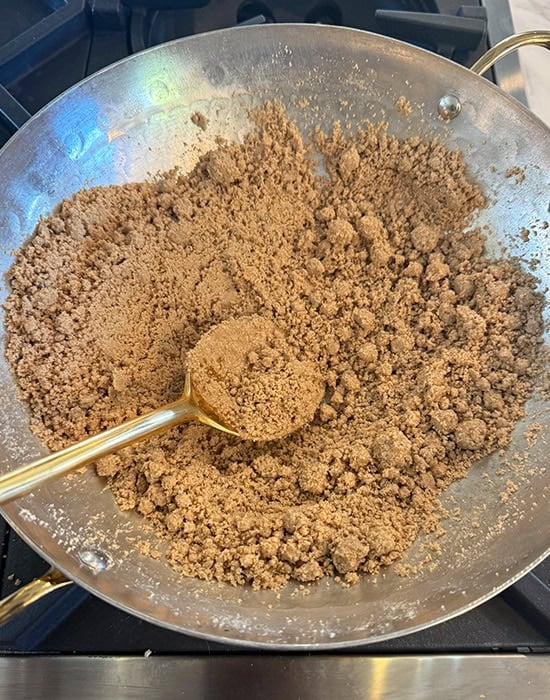

- Grind the nuts and edible gum
Grind the nuts and raisins coarsely, I like using a spice and coffee grinder that I have for this. When you grind the nuts, make sure to grind them coarsely and not turn it into a fine powder. I like having some chunks of nuts in my panjiri. Also crush the gond (edible gum) using a mortar and pestle. This retains the texture of the gond and gives a nice crunch to your panjiri. Don’t turn it into a powder. And if there are some pieces of gond which you are unable to crush with a pestle, just discard them. You don’t want that in your panjiri, they will be difficult to crush with your teeth.
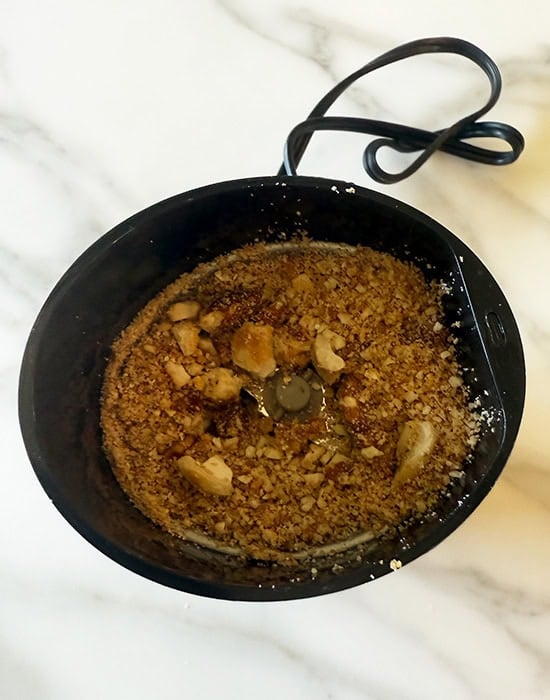
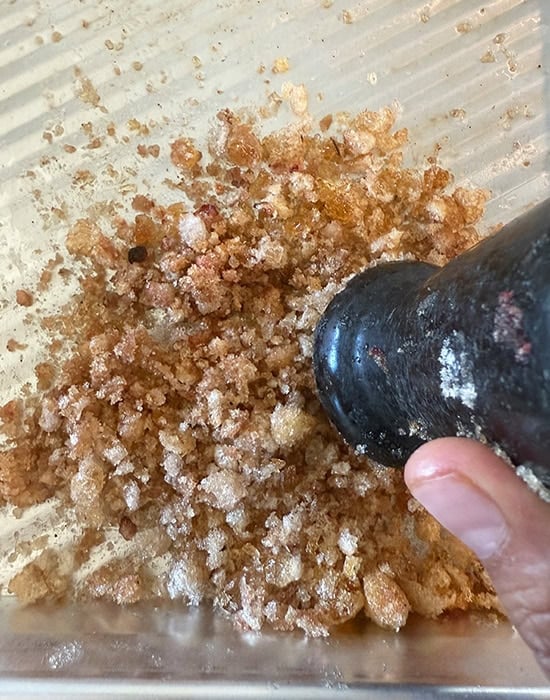
- Add sugar and mix everything together
Now, mix everything together in a large plate- roasted atta, coarsely ground nuts, crushed gond and sugar (bura). I like using bura here and I would recommend you do the same. Don’t use powdered sugar (aka icing sugar/confectioners sugar), bura gives texture to panjiri so use that for this recipe. You can add spices like cardamom powder, ground ginger and fennel powder at this point.
If you can’t find bura, transfer your regular white granulated sugar to a mixer and grind it a few times and then use in the recipe.
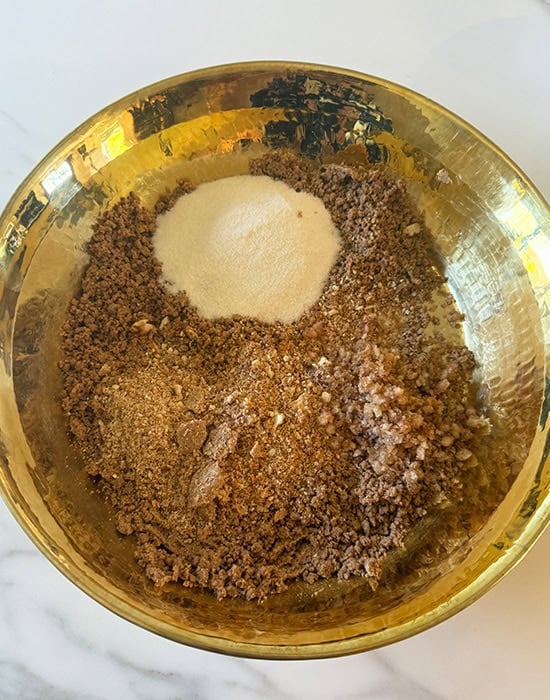
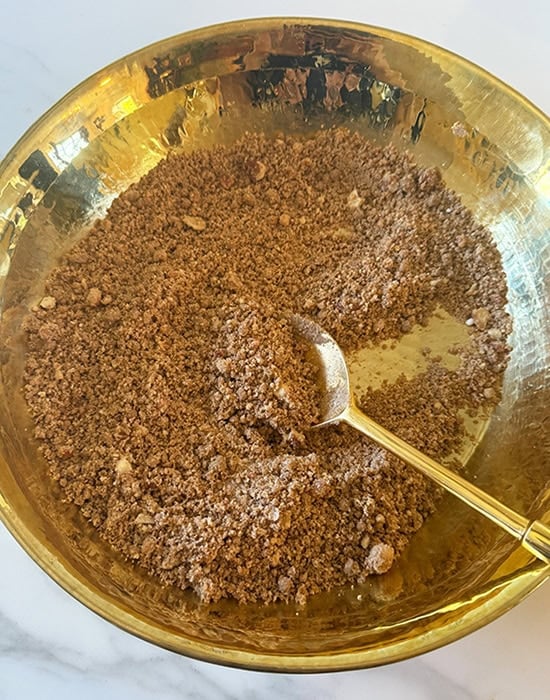
Manali’s Tips
Here are some important tips for me that you must keep in mind while making panjiri!
- Use ghee liberally when making panjiri. A good panjiri needs a good amount of ghee, so use the amount mentioned in the recipe.
- Make sure to use a heavy bottom pan or kadai to make panjiri, a light weight pan will cause the atta to burn even before it’s roasted.
- The atta needs to be roasted on low heat for 15 to 20 minutes, this step needs patience, so do not rush it. And stir constantly else the atta will burn.
- Once the atta is roasted, take it out of the pan and transfer it to a large plate, keep stirring it even then for 2 minutes so that it doesn’t burn.
- Let the atta come down to room temperature before adding sugar to it. If you add sugar while atta is still hot, the sugar will melt and your panjiri will become pasty.
- For best texture, use bura or khand and not powdered sugar in panjiri.
- Crush your nuts and gond coarsely, you want some bits and pieces in the panjiri, it adds to the texture.
Storage
Panjiri can be store at room temperature for 5 to 6 weeks in an airtight container. Honestly, it doesn’t last that long in my home! If you freeze the panjiri, it will last longer.
Notes
- Some people add sooji or besan to their panjiri but I like to keep it simple. Adding sooji gives texture to panjiri but you can also achieve that by coarsley crushing the gond and using bura in the recipe.
- To flavor the panjiri, spices like ginger, fennel, black pepper, cardamom are used. Panjiri was especially made during winters in India and so warming spices like pepper, ginger were often used. I honestly don’t add any flavor because I love the flavor of atta and ghee but you can use whichever spice you like.
- You can also ingredients like makhana, melon seeds, and pumpkin seeds to your panjiri. You would need to roast them all before and then grind and use in the recipe. I don’t add any of these in my recipe.
Panjiri Recipe (Step by Step)!
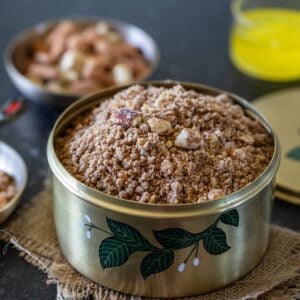
Ingredients
To Roast the Nuts/Gum
- 2 & ½ tablespoons ghee divided
- ¼ cup almonds 37 grams , use raw almonds
- ¼ cup cashews 38 grams , use raw cashews
- 2 tablespoons golden raisins 25 grams
- 2 tablespoons edible gum 30 grams , also known as gond
Everything Else
- ½ cup + 2 tablespoons ghee 125 grams
- 2 cupa atta approx. 250 grams
- ½ cup bura approx. 100 grams
- ½ teaspoon cardamom powder optional
Instructions
Fry the nuts/gum/raisins
- Take a heavy bottom kadai/pan (iron or brass works best) and add 2 tablespoons ghee to it on medium heat. Once the ghee is hot, add ¼ cup almonds (37 grams) and ¼ cup cashews (38 grams) to it. Cook for 1 to 2 minutes until nuts are light golden brown in color and the remove them from the kadai using a skimmer. To the same pan, now add 2 tablespoons golden raisins (25 grams). Cook for 1 minute until they plump up and then remove them using a skimmer as well.
- Now, add an extra ½ tablespoon ghee, and then add 2 tablespoons edible gum (30 grams) to the kadai. Edible gum is called "gond" in hindi. Fry for 1 minute until the gum swells up, and then remove using a skimmer.
Roast the atta
- To the same kadai, now add ½ cup + 2 tablespoons ghee (125 grams) on low heat. Then add 2 cups atta (250 grams) and stir using a spatula. Cook the atta on low heat, stirring constantly until atta turns fragrant and is toasted and golden brown in color. This process takes anywhere between 15 to 20 minutes and needs patience. Do not rush this step. Make sure to stir constantly else the atta will burn and do not increase the heat else the atta will become brown but will still be raw. Once nicely roasted, transfer the atta to a big plate or bowl and continue to stir for 2 more minutes. We do this because there's still heat trapped inside the atta and we don't want it to burn so continue to stir for a minute or two even after removing the atta from heat. And now let the atta cool down to room temperature. You have to wait for it to cool down before mixing in the sugar else the sugar will melt and you will have a halwa (pudding) instead!
Grind the nuts/gum
- While the atta is getting cooled, transfer the roasted nuts and raisins to a grinder and pulse a few times to grind them coarsely. Don't make a fine powder. Some pieces of nuts give a lot of texture to the panjiri. Crush the edible gond using a mortar and pestle. Again, crushing it like this, will add texture to panjiri but you can also grind it if you want.
Mix everything together
- Once the atta has cooled down to room temperature, add 100 grams/ ½ cup bura (see note 1) along with the ground nuts, raisins and crushed gond. Mix everything together using a spoon or your hands. You can also add ½ teaspoon cardamom powder or ground ginger if you like. I keep it plain since that's how my nani made it! Store panjiri in an airtight container and it will last for 2 to 3 weeks.
Notes
- Bura is a type of sugar that’s made by boiling water with sugar and then letting the sugar crystallize. The moisture from sugar gets evaporated so bura has more texture and more flavor than regular sugar.
- This recipe makes around 4 cups of panjiri, or 570 grams approx.
Nutrition
Nutrition information is automatically calculated, so should only be used as an approximation.

